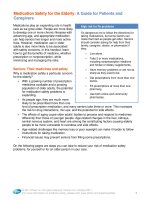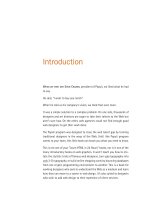Making the team a guide for managers fifth edition 5th edition by thompson test bank
Bạn đang xem bản rút gọn của tài liệu. Xem và tải ngay bản đầy đủ của tài liệu tại đây (624.43 KB, 6 trang )
Making the Team A Guide For Managers Fifth Edition 5th
edition by Thompson Test Bank
Link full download test bank: />
MULTIPLE-CHOICE QUESTIONS – CHAPTER 2
1. Teams ideally need a supportive organizational context – one that recognizes and
welcomes their existence, and responds to their requests for information, resources, and
action as well as legitimizes the team’s task. Of the following, which is a component of
team design?
a. Organizational reporting relationships
b. Functional units
c. The leadership style within the team
d. The reward system
(c; p. 24; Moderate; Concept Q)
2. The organizational context, team design, and team culture are three important
aspects that affect the ultimate performance of a team. Which of these three aspects
does a leader have the most control over?
a. The organizational context
b. Team design
c. Team culture
d. All three about equally
(b; p.24-25; Moderate; Concept Q; Communication abilities)
3. Team culture refers to the:
a. personality of a team.
b. ethnic origin of the team members.
c. extent to which team members are polite and respectful to one another.
d. geographical location of the
team. (a; p.25; Easy; Concept Q)
4. Goal contagion is a form of norm setting in which people adopt a goal held by others.
Goal contagion is more likely in what circumstance?
a. When the team desires or admires a goal held by a competing team
b. Between people in the same work group or team
c. Adopted when a team member wishes to differentiate themselves from the group
d. A person feels threatened by other members of the team to adopt a certain goal.
(b; p. 25; Challenging; Concept Q; Communication abilities)
5. A team norm is best described as:
a. the personality of the team.
b. a generally agreed upon set of rules that guides the behavior of team members.
c. a goal held by the group that is adopted by a newcomer.
d. the normal number of people to be on a given team.
(b; p.25; Easy; Concept Q)
Copyright © 2014 Pearson Education Inc.
6. In regards to expertise, critical skills for team members include all of the following
EXCEPT:
a. conflict resolution.
b. collaborative problem solving.
c. a large network of influential company contacts.
d. a strong ability to communicate effectively.
(c; p. 26; Easy; Concept Q)
7. A number of factors must be in place for a team to perform well. All of the following are
considered essential for team effectiveness EXCEPT the:
a. knowledge and skill regarding the team task.
b. motivation to accomplish the goals of the team.
c. ability to identify the different personality styles of team members.
d. ability to coordinate effort and communicate well with
others. (c; p.26; Moderate; Concept Q)
8. Which of the following is true about how stress and pressure can affect
individual performance?
a. Performance improves only for tasks that require high motivation.
b. Performance on a well-learned task improves.
c. Performance on a novel task improves.
d. Stress never enhances performance.
(b; p.27; Moderate; Concept Q)
9. Which of the following situations demonstrates the best example of social facilitation?
a. Mary, who is a new member of the ballet class, is asked to demonstrate a step
sequence for the senior members of the company. Mary is concerned that her
technique will not be up to par with the rest of the team.
b. John is an excellent lead dancer, and when learning a new routine, loses track
of time because he is so engaged in his task.
c. Sonya is an up and coming dancer, and her teacher puts quite a bit of pressure on
her to perform perfectly. In her dance recital, despite weeks of rehearsals,
Sonya’s mind goes blank, and she can’t remember her routine.
d. Julia is a strong dancer, and when asked to demonstrate her solo to a room full of
classmates, her performance is more energetic, and her leaps are higher.
(d; p. 28-29; Moderate; Critical thinking Q; Reflective thinking skills)
10. When in the psychologic state of “Flow”, which of the following is the most true?
a. A person is keenly aware of the time they are spending on the task at hand.
b. For the individual, the process of engaging in the task is its own reinforcement.
c. A person is intimidated by the task.
d. A person is extremely relaxed, and very comfortable with the task at hand.
(b; p. 29; Moderate; Concept Q)
Copyright © 2014 Pearson Education Inc.
11. Regarding Csikszentmihalyi’s model of Flow, when a person is very low in skill ability, and
the task is high in complexity, what emotional state might this person experience?
a. Control
b. Flow
c. Anxiety
d. Inspiration
(c; p.29; Moderate; Concept Q)
12. The belief that a group has in themselves, or their group potency, a significant
predictor of actual performance. This “thinking we can”, contributes to group
performance more than the __________.
a. team norms
b. diversity of team members
c. pure cognitive abilities of the team
d. individual, positive illusion biases
(c;p.30; Moderate; Concept Q)
13. The Kohler Effect refers to the observation that:
a. members work harder in a team than they do alone under some conditions.
b. members don’t work as hard in a team as they do alone under some conditions.
c. people work less hard in smaller groups than they do in larger groups.
d. people work harder when they are in a flow state.
(a; p. 30-31; Easy; Concept Q )
14. The social loafing effect refers to the tendency for:
a. people in teams to let others make mistakes instead of telling them what to do.
b. teams to take longer to complete a task than individuals.
c. teams to be more creative than individuals, but experience more conflict.
d. people not to work as hard in teams as they would if they were working individually.
(d; p.31; Easy; Concept Q )
15. In a team, a person’s efforts are less identifiable than when that person
works independently. Because the person’s efforts are less identifiable, in
extreme circumstances this can lead to __________.
a. relational loss – or when an employee perceives that support is less available as
team size increases.
b. choking under pressure – a person’s performance declines despite incentives for
optimal performance.
c. a positive illusion bias – or unwarranted beliefs in one’s own superiority.
d. deindividuation – a psychological state in which a person does not feel
individual responsibility.
(d; p. 33; Challenging; Concept Q)
16. If you detect a free rider on your team, the best way to remedy the situation is to:
a. stop carpooling with members of the team.
b. increase the identifiability of that person’s work products through performance
reviews.
Copyright © 2014 Pearson Education Inc.
c. increase the size of the team.
d. decrease the difficulty of the team task.
(b; p. 34; Moderate; Concept Q)
17. When the least capable member of a team feels particularly indispensable for group
success, the entire group works harder to achieve their goals. This effect is best termed:
a. team identifiability.
b. positive illusion bias.
c. social striving effect.
d. relational loss.
(c; p.34; Moderate; Concept Q)
18. Which of the following actions by the team or their leadership can result in reduced
team performance?
a. The team leader promotes an intrinsically interesting or challenging project.
b. The team leader rewards a team member with a clock for his or her hours of
overtime spent in the service of a team’s project.
c. The team shares, and mutually sets, their own performance goals.
d. Team leaders increase team size so that more employees get an opportunity to
contribute to the project.
(d; p. 34-37; Moderate; Concept Q; Analytic skills)
19. The positive illusion bias refers to:
a. people who believe themselves to be superior and more talented than others on their
team.
b. people who work harder for the team hoping to improve the overall team’s reputation
within the larger organizational context.
c. managers who convey a positive attitude in order to positively influence their team’s
group mood.
d. a team member who has positive news to share about the group’s task in hopes
that it will spur morale and increase productivity.
(a; p. 35; Easy; Concept Q; Ethical understanding and reasoning abilities)
20. The positive illusion bias, or unwarranted beliefs in one’s own superiority, can
wreak havoc in teams. Why?
a. Individuals believe their contributions will not be sufficient to justify their efforts.
b. Individuals with this bias are interested in vastly different team goals than that of
their other teammates.
c. Individuals who see themselves as above average are likely to engage in social
loafing because they have a false sense of the value of their contributions.
d. Individuals with this bias always have a high sense of the Protestant Work
Ethic. (c; p.35; Easy; Concept Q; Ethical understanding and reasoning abilities)
21. As team size gets larger and larger, team members perceive that there is less support
available, and freeriding increases. This experience can lead to:
a. diminished motivation.
b. lower performance.
c. greater cohesion between team members.
Copyright © 2014 Pearson Education Inc.
d. both a and b.
(d; p. 37; Easy; Concept Q)
22. Execution is the ability of teams to communicate effectively and combine their efforts.
All of the following can enhance team execution EXCEPT:
a. training team members together.
b. practice and rehearsal.
c. setting clear performance standards.
d. increasing the size of the team.
(d; p. 37-38; Moderate; Concept Q; Communication abilities)
23. Which of the following performance criteria are used to evaluate the success of a team?
a. Productivity
b. Financial profit
c. Diversity
d. Rewards
(a; p. 39-42;Moderate; Concept Q)
24. The team performance equation attempts to predict the actual productivity of a team. It
states that the AP (actual productivity) of a team equals:
a. the potential productivity of a team, plus team synergies, minus team threats.
b. the potential productivity of a team, plus team culture, minus free-riding.
c. the potential productivity of a team, plus task design, plus team culture.
d. cohesion, plus learning, plus integration.
(a; p. 43, ; Easy; Concept Q)
25. Regarding team performance, leaders can more easily control ________than ________.
a. team Integration; team separation
b. performance threats; synergies
c. team cohesion; resources
d. the demands of a task; the process of accomplishing a task
(b; p. 43; Moderate; Concept Q; Communication abilities)
Copyright © 2014 Pearson Education Inc.









